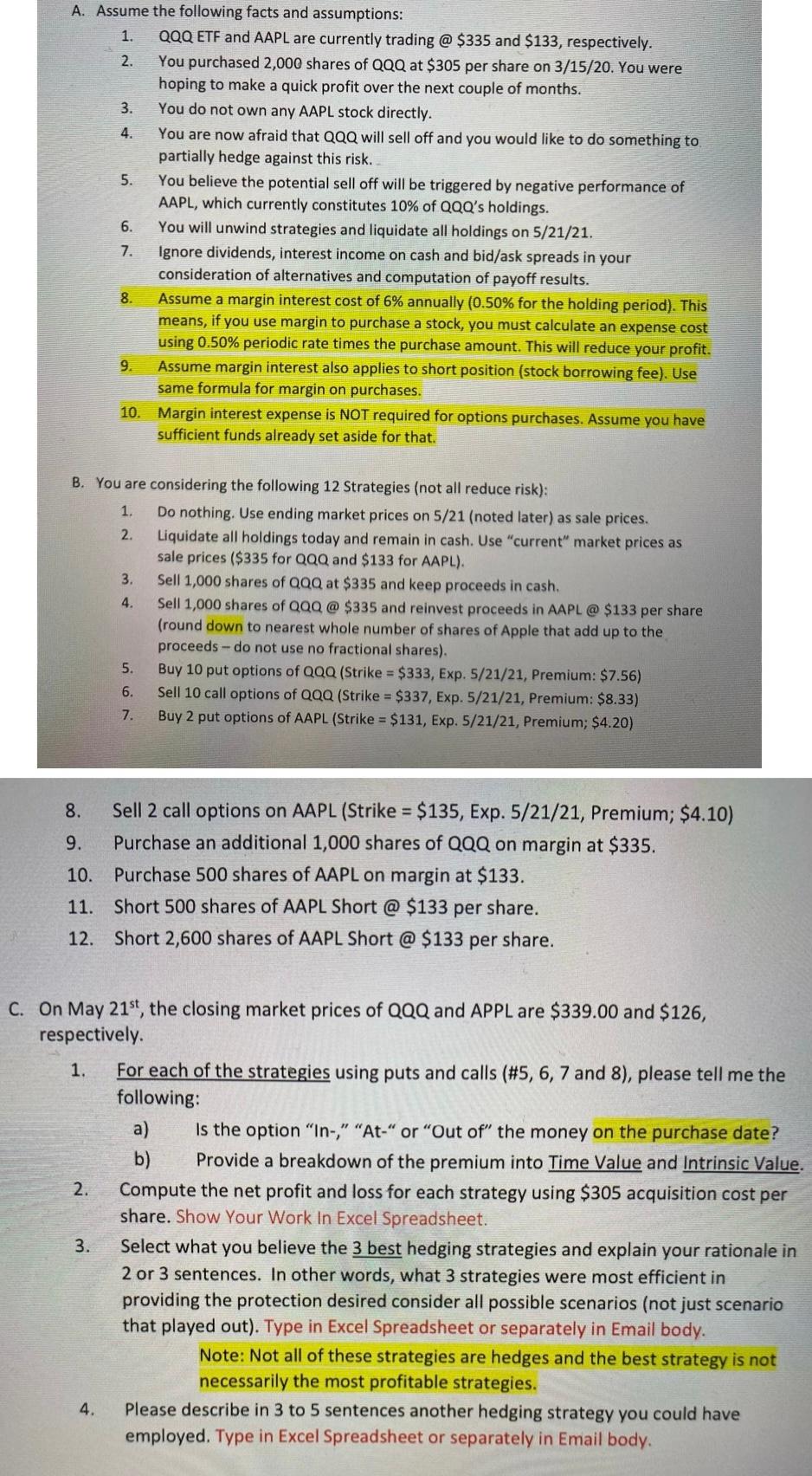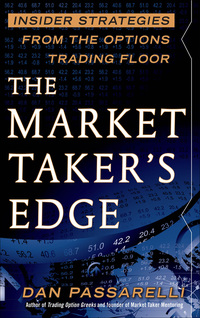
A. Assume the following facts and assumptions: 1. QQQ ETF and AAPL are currently trading @ $335 and $133, respectively. 2. You purchased 2,000 shares of QQQ at $305 per share on 3/15/20. You were hoping to make a quick profit over the next couple of months. 3. You do not own any AAPL stock directly. 4. You are now afraid that QQQ will sell off and you would like to do something to partially hedge against this risk. 5. You believe the potential sell off will be triggered by negative performance of AAPL, which currently constitutes 10% of QQQ's holdings. 6. You will unwind strategies and liquidate all holdings on 5/21/21. 7. Ignore dividends, interest income on cash and bid/ask spreads in your consideration of alternatives and computation of payoff results. 8. Assume a margin interest cost of 6% annually (0.50% for the holding period). This means, if you use margin to purchase a stock, you must calculate an expense cost using 0.50% periodic rate times the purchase amount. This will reduce your profit. 9. Assume margin interest also applies to short position (stock borrowing fee). Use same formula for margin on purchases. 10. Margin interest expense is NOT required for options purchases. Assume you have sufficient funds already set aside for that. B. You are considering the following 12 Strategies (not all reduce risk): 1. Do nothing. Use ending market prices on 5/21 (noted later) as sale prices. 2. Liquidate all holdings today and remain in cash. Use "current" market prices as sale prices ($335 for QQQ and $133 for AAPL). 3. Sell 1,000 shares of QQQ at $335 and keep proceeds in cash. 4. Sell 1,000 shares of QQQ @ $335 and reinvest proceeds in AAPL @ $133 per share (round down to nearest whole number of shares of Apple that add up to the proceeds - do not use no fractional shares). 5. Buy 10 put options of QQQ (Strike = $333, Exp. 5/21/21, Premium: $7.56) 6. Sell 10 call options of QQQ (Strike = $337, Exp. 5/21/21, Premium: $8.33) 7. Buy 2 put options of AAPL (Strike = $131, Exp. 5/21/21, Premium; $4.20) 8. Sell 2 call options on AAPL (Strike = $135, Exp. 5/21/21, Premium; $4.10) 9. Purchase an additional 1,000 shares of QQQ on margin at $335. 10. Purchase 500 shares of AAPL on margin at $133. 11. Short 500 shares of AAPL Short @ $133 per share. 12. Short 2,600 shares of AAPL Short @ $133 per share. C. On May 21st, the closing market prices of QQQ and APPL are $339.00 and $126, respectively. 1. For each of the strategies using puts and calls (#5, 6, 7 and 8), please tell me the following: a) Is the option "In-," "At-" or "Out of the money on the purchase date? b) Provide a breakdown of the premium into Time Value and Intrinsic Value. 2. Compute the net profit and loss for each strategy using $305 acquisition cost per share. Show Your Work In Excel Spreadsheet. 3. Select what you believe the 3 best hedging strategies and explain your rationale in 2 or 3 sentences. In other words, what 3 strategies were most efficient in providing the protection desired consider all possible scenarios (not just scenario that played out). Type in Excel Spreadsheet or separately in Email body. Note: Not all of these strategies are hedges and the best strategy is not necessarily the most profitable strategies. 4. Please describe in 3 to 5 sentences another hedging strategy you could have employed. Type in Excel Spreadsheet or separately in Email body. A. Assume the following facts and assumptions: 1. QQQ ETF and AAPL are currently trading @ $335 and $133, respectively. 2. You purchased 2,000 shares of QQQ at $305 per share on 3/15/20. You were hoping to make a quick profit over the next couple of months. 3. You do not own any AAPL stock directly. 4. You are now afraid that QQQ will sell off and you would like to do something to partially hedge against this risk. 5. You believe the potential sell off will be triggered by negative performance of AAPL, which currently constitutes 10% of QQQ's holdings. 6. You will unwind strategies and liquidate all holdings on 5/21/21. 7. Ignore dividends, interest income on cash and bid/ask spreads in your consideration of alternatives and computation of payoff results. 8. Assume a margin interest cost of 6% annually (0.50% for the holding period). This means, if you use margin to purchase a stock, you must calculate an expense cost using 0.50% periodic rate times the purchase amount. This will reduce your profit. 9. Assume margin interest also applies to short position (stock borrowing fee). Use same formula for margin on purchases. 10. Margin interest expense is NOT required for options purchases. Assume you have sufficient funds already set aside for that. B. You are considering the following 12 Strategies (not all reduce risk): 1. Do nothing. Use ending market prices on 5/21 (noted later) as sale prices. 2. Liquidate all holdings today and remain in cash. Use "current" market prices as sale prices ($335 for QQQ and $133 for AAPL). 3. Sell 1,000 shares of QQQ at $335 and keep proceeds in cash. 4. Sell 1,000 shares of QQQ @ $335 and reinvest proceeds in AAPL @ $133 per share (round down to nearest whole number of shares of Apple that add up to the proceeds - do not use no fractional shares). 5. Buy 10 put options of QQQ (Strike = $333, Exp. 5/21/21, Premium: $7.56) 6. Sell 10 call options of QQQ (Strike = $337, Exp. 5/21/21, Premium: $8.33) 7. Buy 2 put options of AAPL (Strike = $131, Exp. 5/21/21, Premium; $4.20) 8. Sell 2 call options on AAPL (Strike = $135, Exp. 5/21/21, Premium; $4.10) 9. Purchase an additional 1,000 shares of QQQ on margin at $335. 10. Purchase 500 shares of AAPL on margin at $133. 11. Short 500 shares of AAPL Short @ $133 per share. 12. Short 2,600 shares of AAPL Short @ $133 per share. C. On May 21st, the closing market prices of QQQ and APPL are $339.00 and $126, respectively. 1. For each of the strategies using puts and calls (#5, 6, 7 and 8), please tell me the following: a) Is the option "In-," "At-" or "Out of the money on the purchase date? b) Provide a breakdown of the premium into Time Value and Intrinsic Value. 2. Compute the net profit and loss for each strategy using $305 acquisition cost per share. Show Your Work In Excel Spreadsheet. 3. Select what you believe the 3 best hedging strategies and explain your rationale in 2 or 3 sentences. In other words, what 3 strategies were most efficient in providing the protection desired consider all possible scenarios (not just scenario that played out). Type in Excel Spreadsheet or separately in Email body. Note: Not all of these strategies are hedges and the best strategy is not necessarily the most profitable strategies. 4. Please describe in 3 to 5 sentences another hedging strategy you could have employed. Type in Excel Spreadsheet or separately in Email body







